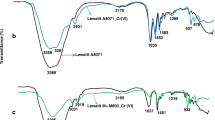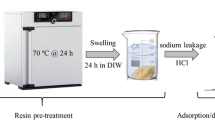Abstract
In this study the selective adsorption method was chosen to enable the recovery of erythromycin. The following sorbents were tested: neutral resins (XAD-4, XAD-7 and XAD-16) and an anionic resin (IRA-410). A mathematical kinetic model for the adsorption of erythromycin against time, on XAD-4, XAD-7 and XAD-16 resins, is proposed. Both Freundlich and Langmuir models showed a good fit for the sorbents XAD-7 and IRA-410 resins. The highest adsorption efficiency was observed when synthetic neutral resin, XAD-7 and XAD-16, were used. The estimated affinity and concentration factors show that the neutral resins tested are adequate for the selective adsorption of erythromycin. The estimated values of enthalpy and free energy of adsorption, lower than 12 kJ mol−1 and −2 kJ mol−1, respectively, indicate that a physiosorption process occurred.





Similar content being viewed by others
References
Seevaratnam S, Holst O, Hjorleifsdottir S, Mattiasson B (1991) Extractive bioconversion for lactic acid production using solid sorbent and organic solvent. Bioprocess Eng 6:35–41
Payne GF, Payne NN, Ninomya J, Shuler ML (1989) Adsorption of nonpolar solutes onto polymeric sorbents. Sep Sci Technol 24:457–465
Maity N, Payne GF, Chipchosky JL (1991) Adsorptive separations based on the diferences in solute–sorbent hydrogen-bonding strengths. Ind Eng Chem Res 30:2456–2463
Belter PA, Cussler EL, Hu WS (1988) Bioseparations—Downstream processing for biotechnology. Wiley, New York, pp 145–179
Doran PM (1995) Bioprocess engineering principles. Academic, London, pp 234–235
Cussler EL (1997) Diffusion mass transfer in fluid systems, 2nd edn. Cambridge University Press, New York, pp 308–330
Mattson JS, Mark HB (1971) Activated carbon-surface chemistry and adsorption from solution. Marcel Dekker, New York, pp 1–31
Payne GF, Ninomiya Y (1990) Selective adsorption of solutes based on hydrogen bonding. Sep Sci Technol 25:1117–1129
Payne GF, Shuler ML (1988) Selective adsorption of plant products. Biotechnol Bioeng 31:922–928
Ribeiro MHL, Prazeres DMF, Cabral JMS, da Fonseca MMR (1995) Adsorption studies for the separation of L-tryptophan from L-serine and indole in a bioconversion medium. Bioprocess Eng 12:95–102
Marshall VP, McWethy SJ, Sirotti JM, Cialdella JI (1990) The effect of neutral resins on the fermentation production of rubradirin. J Ind Microbiol 5:283–288
Barboza M, Hokka CO, Maugeri F (2002) Continuous cephalosporin C purification: dynamic modelling and parameter validation. Bioprocess Biosyst Eng 25:193–203
Ribeiro MHL, Silveira D, Ferreira-Dias S (2002) Selective adsorption of limonin and naringin from orange juice to natural and synthetic adsorbents. Eur Food Res Technol 215:462–471
USP 25-NF 20 (2002) US pharmacopeia, national formulary—the official compendia of standards. pp 675–676
Wankat PC (1990) Rate-controlled separation science. Elsevier Science, London, pp 308–313
Roig MG (1993) Sorption processes. In: Kennedy JF, Cabral JMS (eds) Recovery processes for biological materials. Willey, Chichester, pp 369–414
Geankoplis CJ (1993) Transport processes and unit operations. Prentice Hall, Upper Saddle River, NJ, pp 697–671
Suzuki M (1990) Adsorption engineering. Elsevier Science, Tokyo, pp 35–62
Laidler KJ (1987) Chemical kinetics, HarperCollins, New York, pp 231–232
Ribeiro MHL, Lourenço PA, Monteiro JP, Ferreira-Dias S (2001) Kinetics of selective adsorption of impurities from crude vegetable oil in hexane to activated earths and carbon. Eur Food Res Technol213:132–138
Technical bulletins. Rohm and Haas, Philadelphia, USA
Parfitt GD, Rochester CH (1983) Adsorption of small molecules. In: Parfitt GD, Rochester CH (eds) Adsorption from solution at the solid/liquid interface. Academic, London, pp 3–47
Gregg SJ, Singh KSW (1967) Adsorption, surface area and porosity. Academic, London, pp 1–34, 121–194
Giles CH (1966) Adsorption of small molecules. In: Parfitt GD, Rochester CH (eds) (1983) Adsorption from solution at the solid/liquid interface. Academic, London, pp 367–370
Giles CH (1974) Adsorption of small molecules. In: Parfitt GD, Rochester CH (eds) (1983) Adsorption from solution at the solid/liquid interface. Academic, London, pp 10–13
Chaubal MV, Payne GF, Reynolds CH, Albright RL (1995) Equilibria for the adsorption of antibiotics onto neutral polymeric sorbents: experimental and modeling studies. Bioprocess Eng 12:95–102
Author information
Authors and Affiliations
Corresponding author
Rights and permissions
About this article
Cite this article
Ribeiro, M.H.L., Ribeiro, I.A.C. Modelling the adsorption kinetics of erythromycin onto neutral and anionic resins . Bioprocess Biosyst Eng 26, 49–55 (2003). https://doi.org/10.1007/s00449-003-0324-2
Received:
Accepted:
Published:
Issue Date:
DOI: https://doi.org/10.1007/s00449-003-0324-2




